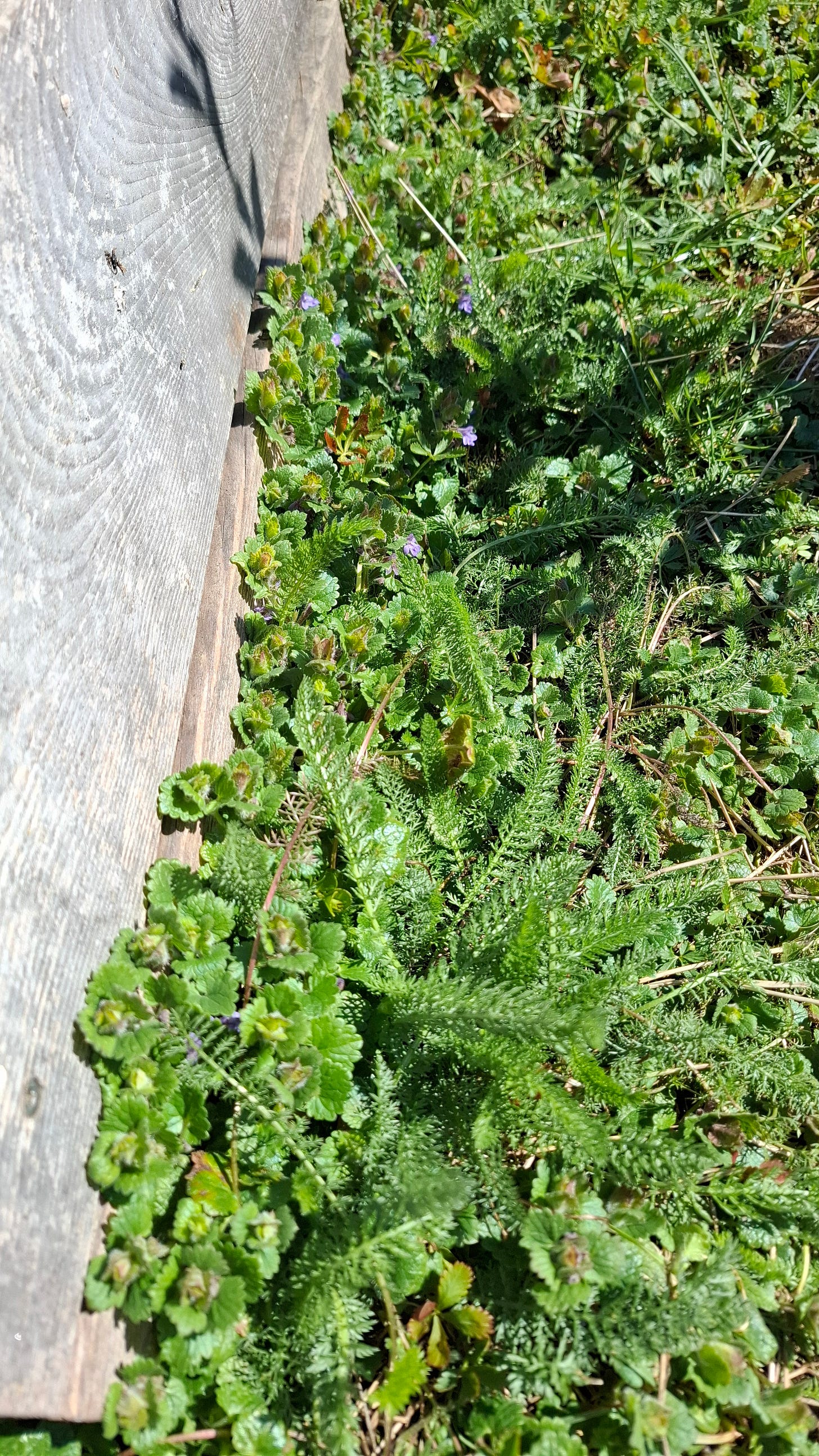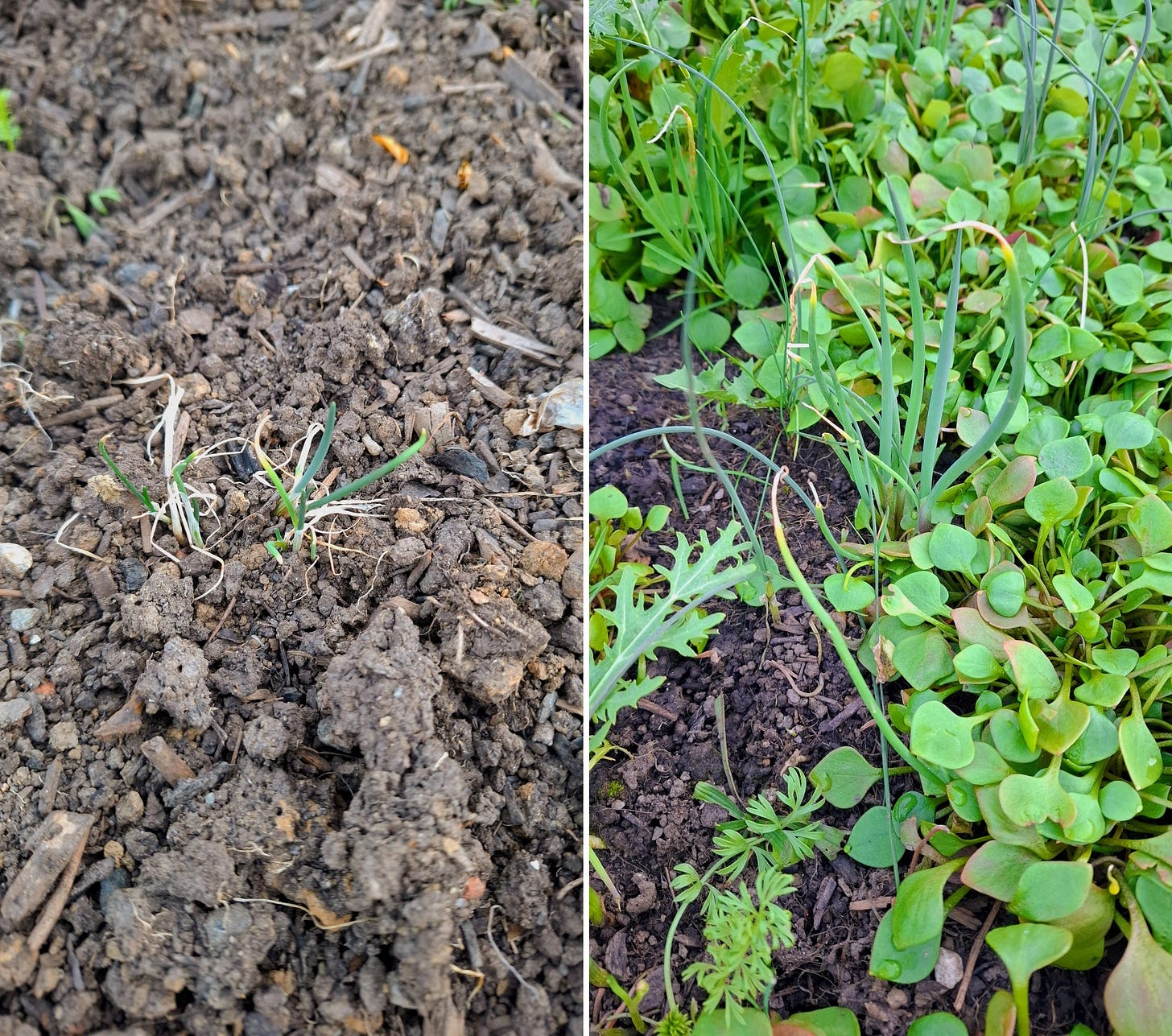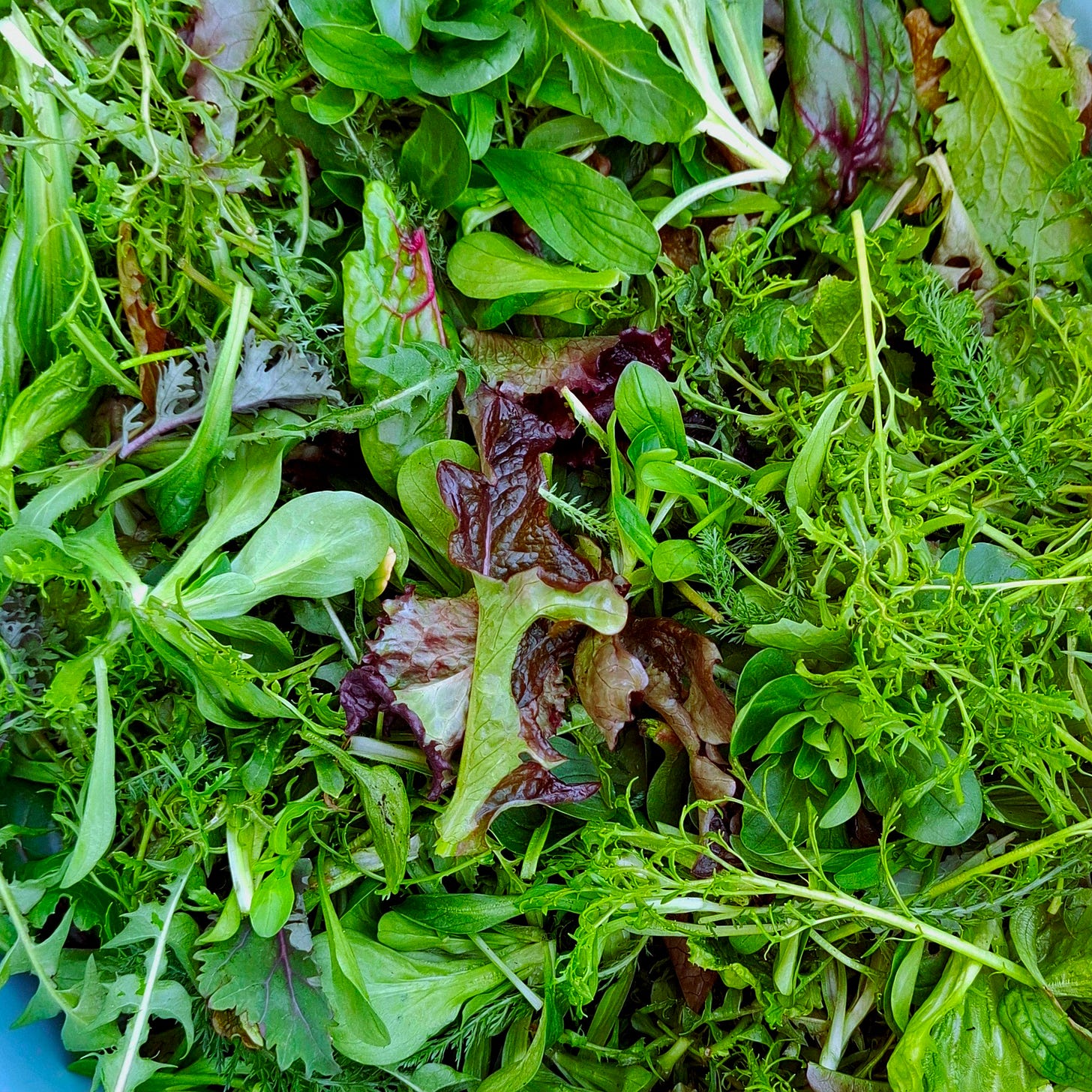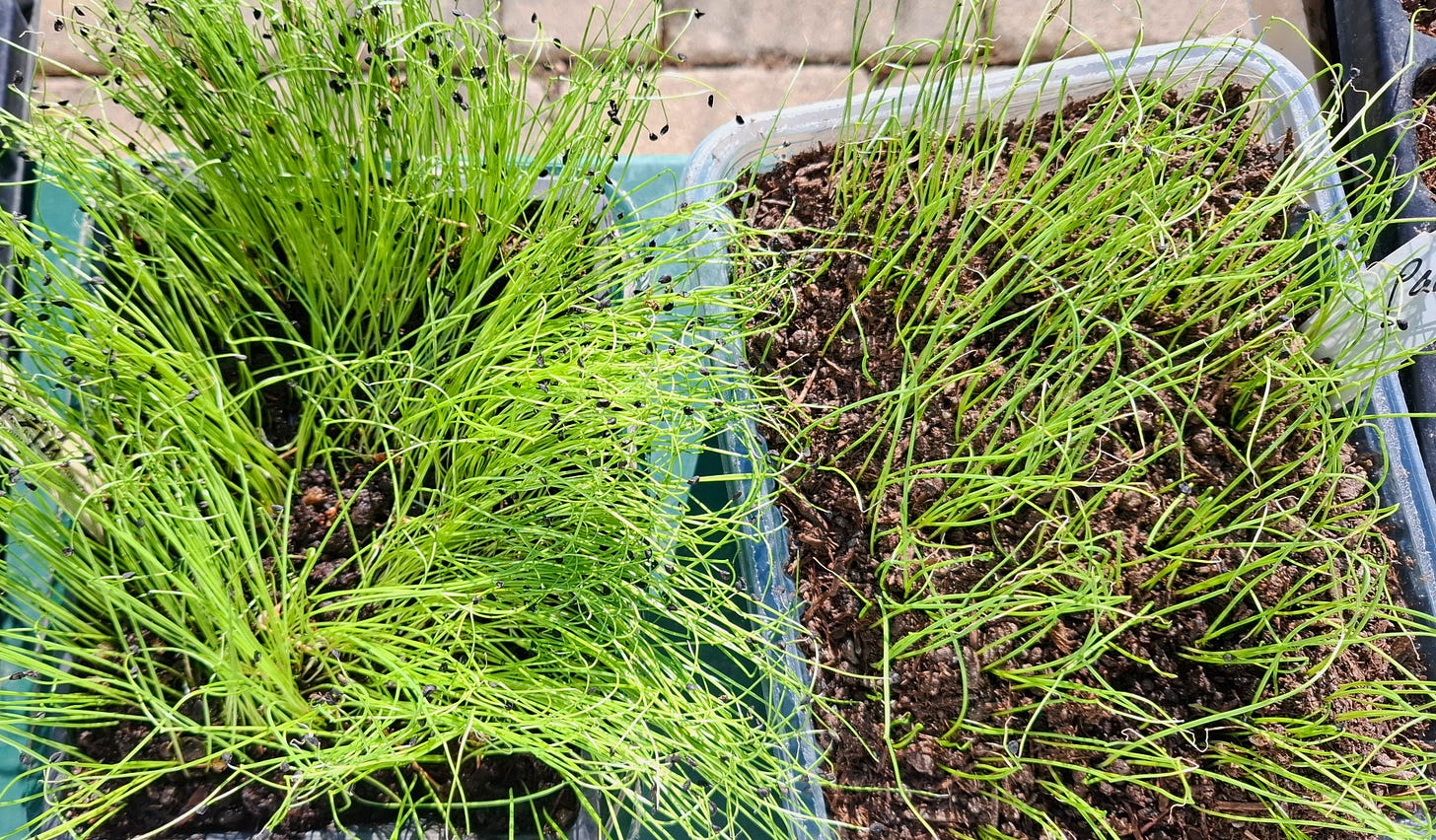Celebrating with Gratitude
If a plant is full of purpose and potential, it can't be a weed. Plus, surprisingly viable allium seeds, tending seedlings, this week's salad mix, and a special anniversary.
Last week’s fool’s spring was followed by a cold snap in my part of the world. We had several nights of below-freezing temperatures, but now milder weather is returning. I’m not necessarily happy about that, knowing that the unusually mild days and nights are the new normal. Nonetheless, I stay with my regular planting schedule, which means I feel astoundingly at ease with not having started the outdoor beds in the market garden.
Instead, my time has been devoted to writing about Esther Deans this week, a forgotten (ignored?) pioneer of no-dig gardening. The article will appear next week as a special “Deep Dive” for all subscribers. I was thinking about her and this week’s salad mix (the next “Deep Dive” for paid subscribers) while I was watering the transplants and checking on the edibles in the flower bed and demonstration garden. As I was raising the windows on the cold frame, I noticed the yarrow and ground ivy growing on the perimeter. Perfect. Esther Deans would be pleased, because she related to “weeds” much like I do:
“Leave some growing, particularly around the edges as I have mentioned, to bind the soil so that it will not wash away during a downpour. Weeds are helpful in this way and a few won't destroy the garden or rob the plants of too much nutrition.” (p. 27)
What she didn’t know (but we now do): All plants give more than they extract. All plants foster the soil microbiome in their root zone. Overwintered wild plants, such as dandelion and thistle, are feeding stations for earthworms in early spring. I let them grow until I need the space for my crops. And I swear by living paths.
Young yarrow leaves (Achillea millefolium) are a delightful edition to a spring salad mix, pleasantly bitter, slightly grassy, a note of anise seed. The ground ivy (Glechoma hederacea) along with garden sorrel, chives, oregano (Origanum vulgare), cress, and chervil made up this week’s green sauce mix, too. Unfortunately, there’s no parsley, which didn’t make it last fall. Normally, the polytunnel would have a square meter of lush, curly leaves at this time of the year, sowed late in July for overwintering. (In my climate, flat-leafed parsley isn’t winter-hardy.)
“Weeds” are not a botanical category, by the way. They are a concept. When I discovered the financial backers of the Weed Science Society of America have a vested interest in demonizing wild plants, it became very clear who is funding “weed science” and why. The European Weed Research Society has similar roots in the agro-chemical industry, although it has morphed a bit to include ecosystems and agroecology, thereby gaining access to European Union funding. The use of herbicides is still par for the course in their world.
As a result, I have stopped using the word “weeds” as much as possible. In German, it’s easy: Instead of “Unkraut” (literally, “non-plants”), I say “Beikraut” (“neighboring plants”). In English, it’s not so easy. Wild plants? Non-domesticated plants? Unwanted? Unplanned? Nature’s volunteers? Nature’s soldiers? The latter comes to mind, because many common wild plants colonize disturbed soil to protect it, a need created by agricultural (and gardening) practice.

The truth is, we have a lot to learn from the wild plants that inhabit our gardens. Most of them are bioindicators, meaning they tell us something about the soil and growing conditions. Yarrow is an indicator for nitrogen-rich soil. It is also an ancient healing herb. Its Latin name, Achillea millefolium, relates to ancient mythology. Achilles supposedly treated his wounded heal with yarrow. Millefolium is a description of the leaves: thousands of leaves. I used to use the flowers in an herbal tea mix for women’s health, also including red clover, mint, lemon balm, thyme, and mallow flowers. In Germany, yarrow was plant of the year in 2021, in part due to its drought tolerance.
So is yarrow a weed? Not in my book, although it can become problematic when it ignores the frame of the cold frame and creeps into the bed or takes up too much of the flower beds. Similarly, ground ivy indicates nutrient-rich soil, preferring half-shade and moist conditions with a balanced pH. Like yarrow, it has been used since ancient times to heal wounds, among other things.
Both are pollinator-friendly. Wild bees are very busy when the delicate purple flowers of ground ivy appear in spring. Yarrow is visited by butterflies, wasps, flies, and bees, although given a choice bees visit other flowers in my garden. With all of that purpose and potential, how could I call either a weed? On the other hand, volunteer claytonia (miner’s lettuce) has taken over in parts of the polytunnel and the demonstration garden, very weed-like. This week, I was pleased that the chef ordered a decent portion, because I have more than enough. It’s staying in place, though, until I need the space, because it has served well over the winter.
Here’s how it has served: Bunching onions planted in November had a hard time in the polytunnel this winter due to lack of moisture. The ones on the left are just waking up. They grew with nothing else around them, unlike the ones on the right that grew in a thick mat of claytonia. The claytonia germinated at the end of November and held in moisture wherever it grew. It also protected the more frost-sensitive frisée from freezing too hard, which means I can still pick for salad mix.

Claytonia and lamb’s lettuce/cornsalad are at their peak. Some of the lamb’s lettuce displays side shoots and curling leaves, indicating it is about to bolt. One of our salads this week was a quick pick in the kitchen garden, made up of claytonia, round- and long-leafed lamb’s lettuce, and two Asian mustards (‘Green Frills’ and ‘Green in Snow'):



Tending transplants and being suprised by alliums
Tending transplants is becoming more time-consuming. This week we had two very sunny days but chilly outdoor temperatures, too cold to put pepper and eggplant transplants outside. The sunroom heats up like a sauna on sunny days, so I’ve had to open a window or two and water more because the plants are thirsty. A disadvantage of the sunroom is not being able to use the hose. My watering can is exactly enough for bottom-watering three trays, so that means several trips at this point.
The tomato seedlings are getting sunbaths in the afternoon, when the temperatures allow. Both of my Bulgarian tomato varieties didn’t want to germinate this year. They’ve always been finicky, but this year none of them appeared. They’re very similar to Brandywine types, so I think they have just dropped out of my collection - more room for others next year.
My big surprise this week were alliums. A week ago I sowed some three-year-old seed I had discovered in my stash. Thinking it wouldn’t germinate, I sowed thickly. Little did I know. The European welsh onions germinated within five days. All of them. The next day, the onions appeared (my favorite, ‘Hâtif de Paris’) and two days later the leeks. I’m going to make an educated guess as to why the seeds were still viable and vigorous: the seed microbiome was healthy. I sowed them with husks still clinging to them, which also might have helped. More wonderfully nerdy information about the seed microbiome from Sam Knowlton is here.
A year ago today…
This season will be a total reboot in the market garden, downsizing and further simplifying. Last season, after two pulmonary embolisms and a hospital stay, everything came to a screeching halt and the market garden returned to a meadow. This weekend is my one-year anniversary. Last year at this time, I was in a polytunnel, bent over picking lettuce. When I stood up, I had the worst dizziness I’ve ever experienced and my heart felt like it was on overdrive. I thought I would pass out, so I held onto a post and concentrated on breathing, which was laborious. Once I felt a bit better, I made my way back to the house, taking a rest every 10 steps and trying to catch my breath. Somehow, I made it through the rest of the evening, cooked dinner, watched a bit of TV, went to bed two hours earlier than usual. The plan: If I wasn’t feeling better, I would go to the doctor the next day.
Our GP did a blood test and immediately sent me to the emergency room. The biomarker for blood clots was high, indicating pulmonary embolism. I landed in intensive care and it took a few days and a cardiologist yelling at me to stay in bed for me to realize what a close call it had been. Now I share what happened, so others can learn from it. Pulmonary embolism is deadly, with a survival rate of 30%, and that’s mainly because people ignore symptoms such as pain in the leg or shortness of breath, misinterpreting them. Even doctors can miss what's going on.
In my case, I had a serious injury in October 2023, which involved a metal stake in the market garden. I was rushing and overlooked it, scraping a large chunk of skin off of my shin. Fortunately, after eight weeks of excellent wound care, the skin had grown back and the wound had closed. I thought I was as good as new. Little did I know that such injuries can cause blood clots, which had probably been kept in check by a compression sock during the healing process for the wound.
By December, I was short of breath and chalked it up to being less “fit” after two months of low activity. In early January, I had an episode (dizziness, breathing problems) that led to a false diagnosis, probably because I waited so long after the episode to see our doctor that the biomarkers were too low to read. Based on my EKG results, he sent me to the ER. The ER doctors found nothing acute and sent me to a cardiologist. Tests showed my heart and vascular system were healthy, leaving doctors puzzles. I was still exhausted and battling with shortness of breath. I did my best to go on about my usual business until that fateful day in the tunnel when the second pulmonary embolism occurred - a so-called “saddle” pulmonary embolism, meaning the veins serving both lungs were clogged. Tests had shown that my heart and vascular system were healthy, but unfortunately that second pulmonary embolism scarred the right chamber of my heart. No wonder - it had been working against all odds to keep the blood flowing.
My advice in a nutshell: Take symptoms of blood clots seriously, including sharp pain, swelling of the legs, and shortness of breath. (I only had the latter.) Demand a blood test for blood clots; they're quick and easy for a doctor to do.

So, I have much to celebrate and be grateful for. We're going to a burger place with friends to celebrate. And whatever happens this season, it will be a good year in comparison!
What I’m doing this week
Spring equinox was yesterday, which in my region means that we had exactly 12 hours of daylight. The quick growth will be starting soon, thanks to the longer days. Despite freezing temperatures in the night, by 9:00 in the morning the polytunnel felt like the tropics yesterday. One section of greens is about to bolt, so I can hoe them down, add some compost, and plant over them.
Five tons of compost will be delivered on Monday, most of which will be going into the second polytunnel, which we uncovered in January. We had a good dose of rain earlier this week and that helped for those tunnel beds to recover from being in artificial conditions for a year.
The market garden is on my list for this week:
Terminate whatever is “over the hill” in the first polytunnel, top off with compost, plant lettuce and sow carrots (both will be decent companions for tomatoes)
Spread spent hay and compost in the second polytunnel and the outdoor beds
Plant bunching onions
Direct sow lettuce, chard, radishes, carrots, and peas
Sow bunching onions, head lettuce and romaine for transplants
Pot up those vigorous welsh onions
As I mentioned last week, the list is growing as we head into full spring.
Thanks for reading! Wishing you sunny spring days,
Tanja






Thanks, Suzanne! Yes, winter purslane is awesome. Do you have a special way to prepare it?
What a harrowing health scare! I’m so glad you recovered. Wise words to be vigilant and wait to see a doctor. Im guilty of doing that too… there is so much great info in this post! Thank you!